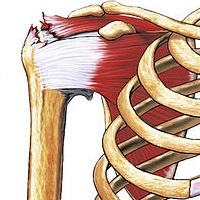
Photo from wikipedia
BACKGROUND Indications for reverse total shoulder arthroplasty (RTSA) have expanded to include primary glenohumeral osteoarthritis (GHOA) with an intact rotator cuff. Limited evidence exists on RTSA in patients with primary… Click to show full abstract
BACKGROUND Indications for reverse total shoulder arthroplasty (RTSA) have expanded to include primary glenohumeral osteoarthritis (GHOA) with an intact rotator cuff. Limited evidence exists on RTSA in patients with primary GHOA and no posterior glenoid wear (Walch A1, A2, and B1 morphologies). The purpose of this retrospective cohort study was to determine if glenoid morphology is associated with clinical outcomes in patients undergoing RTSA for primary GHOA. METHODS A retrospective review of prospectively collected data was performed in patients undergoing primary RTSA for GHOA with a minimum of 2-year clinical follow-up. Preoperative computed tomography (CT) and magnetic resonance imaging (MRI) were used to categorize glenoid morphology as described by the modified Walch Classification. Pre- and postoperative American Shoulder and Elbow Surgeons (ASES), Single Assessment Numeric Evaluation (SANE), visual analog scale (VAS) pain scores, and range of motion (ROM) measurements were compared across Walch glenoid subtypes. The percentage of patients that reached previously established clinically significant thresholds for minimal clinically important difference (MCID) and substantial clinical benefit (SCB), was also comparatively assessed. Multivariable analysis was used to evaluate the association between glenoid morphology and postoperative ASES score while controlling for potentially confounding variables. RESULTS Of the 247 consecutive patients, 197 were available at a minimum 2-year follow-up (80%). Significant improvements were seen in ASES, VAS-pain, SANE, and ROM from baseline to final postoperative follow-up in the combined patient cohort (all P < .001). Most (98.0%) patients reached MCID and 90.9% of patients reached SCB for ASES threshold. No significant differences were found amongst Walch sub-types in terms of pre- to postoperative improvement in ASES (P= .39), SANE (P= .4), VAS-pain (P= .49), forward elevation (P = .77), external rotation (P = .45) or internal rotation (P= 0.1). The only significant difference in postoperative outcomes between Walch glenoid-subtypes was higher postop ASES scores among type-B3 glenoids compared to type-A1 glenoids (P= .03) on univariate analysis. However, no individual Walch glenoid subtype was associated with lower postop ASES scores on multivariable analysis (P>0.05) CONCLUSION: Primary RTSA provides excellent short-term outcomes in patients with glenohumeral arthritis with intact rotator cuff, regardless of the degree of preoperative glenoid deformity. Surgeons can use this data to support the use of reverse total shoulder arthroplasty for glenohumeral arthritis in a more standardized way.
Journal Title: Journal of shoulder and elbow surgery
Year Published: 2021
Link to full text (if available)
Share on Social Media: Sign Up to like & get
recommendations!